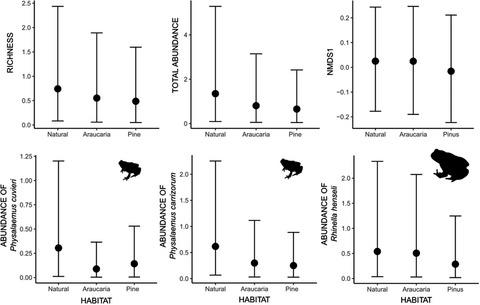当前位置:
X-MOL 学术
›
Austral Ecol.
›
论文详情
Our official English website, www.x-mol.net, welcomes your
feedback! (Note: you will need to create a separate account there.)
Effects of natural forest and tree plantations on leaf-litter frog assemblages in Southern Brazil
Austral Ecology ( IF 1.6 ) Pub Date : 2021-07-11 , DOI: 10.1111/aec.13081 Juciela Cicheleiro 1 , Manuela Santos‐Pereira 2 , André Luís Luza 3 , Douglas da Silva Huning 1 , Noeli Zanella 1
Austral Ecology ( IF 1.6 ) Pub Date : 2021-07-11 , DOI: 10.1111/aec.13081 Juciela Cicheleiro 1 , Manuela Santos‐Pereira 2 , André Luís Luza 3 , Douglas da Silva Huning 1 , Noeli Zanella 1
Affiliation

|
Anuran amphibians are extremely sensitive to changes in the environment and are severely threatened with extinction by human activities. The conversion of natural habitats to tree plantations is expanding in southern Brazil, emphasising the need for both scientists and society to understand the potential effects of this practice on animal communities. Here, we evaluated whether the richness, composition and abundance of leaf-litter frogs change among natural forests, plantations of the native Araucaria angustifolia and plantations of an introduced pine Pinus spp. We obtained data on the composition of the leaf-litter frog assemblages by sampling natural forest and tree plantations in the Passo Fundo National Forest, southern Brazil. We sampled leaf-litter frogs using pitfall trap arrays from March 2017 to February 2018. We used generalised linear mixed models to estimate the effect of habitat type on leaf-litter frogs while considering variation induced by season effect and spatial autocorrelation. We recorded 311 individual leaf-litter frogs belonging to nine species and five families. We did not find differences in species richness and composition, total abundance and abundance of the most frequent species Physalaemus cuvieri, P. carrizorum and Rhinella icterica among Pinus plantations, Araucaria angustifolia plantations and natural forests. These results indicate that tree plantations and natural forests can be equally suitable to leaf-litter frogs. Such suitability is promoted by the light levels of management exerted on these plantations, the old age of the plantations and the heterogeneous mosaic of habitat types maintained within this National Forest. Our study shows that some management decisions can preserve habitat quality to wildlife in modified landscapes.
中文翻译:

巴西南部天然林和人工林对落叶蛙组合的影响
无尾两栖动物对环境变化极为敏感,因人类活动而面临灭绝的严重威胁。在巴西南部,自然栖息地向人工林的转变正在扩大,这强调了科学家和社会都需要了解这种做法对动物群落的潜在影响。在这里,我们评估的丰富性,组成和叶凋落青蛙丰是否改变天然林中,本地的种植园巴西松的介绍松树种植园松属 我们通过对巴西南部 Passo Fundo 国家森林的天然森林和人工林进行采样,获得了落叶蛙组合的组成数据。我们从 2017 年 3 月到 2018 年 2 月使用陷阱陷阱阵列对落叶蛙进行采样。我们使用广义线性混合模型来估计栖息地类型对落叶蛙的影响,同时考虑季节效应和空间自相关引起的变化。我们记录了属于 9 个物种和 5 个科的 311 只落叶蛙。我们没有发现最常见物种Physalaemus cuvieri, P 的物种丰富度和组成、总丰度和丰度的差异。 carrizorum和Rhinella icterica中松种植园、南洋杉种植园和天然林。这些结果表明,人工林和天然林同样适合落叶蛙。对这些人工林实施的轻度管理、人工林的年长以及在这个国家森林内维持的栖息地类型的异质镶嵌促进了这种适宜性。我们的研究表明,一些管理决策可以在修改后的景观中保护野生动物的栖息地质量。
更新日期:2021-07-11
中文翻译:

巴西南部天然林和人工林对落叶蛙组合的影响
无尾两栖动物对环境变化极为敏感,因人类活动而面临灭绝的严重威胁。在巴西南部,自然栖息地向人工林的转变正在扩大,这强调了科学家和社会都需要了解这种做法对动物群落的潜在影响。在这里,我们评估的丰富性,组成和叶凋落青蛙丰是否改变天然林中,本地的种植园巴西松的介绍松树种植园松属 我们通过对巴西南部 Passo Fundo 国家森林的天然森林和人工林进行采样,获得了落叶蛙组合的组成数据。我们从 2017 年 3 月到 2018 年 2 月使用陷阱陷阱阵列对落叶蛙进行采样。我们使用广义线性混合模型来估计栖息地类型对落叶蛙的影响,同时考虑季节效应和空间自相关引起的变化。我们记录了属于 9 个物种和 5 个科的 311 只落叶蛙。我们没有发现最常见物种Physalaemus cuvieri, P 的物种丰富度和组成、总丰度和丰度的差异。 carrizorum和Rhinella icterica中松种植园、南洋杉种植园和天然林。这些结果表明,人工林和天然林同样适合落叶蛙。对这些人工林实施的轻度管理、人工林的年长以及在这个国家森林内维持的栖息地类型的异质镶嵌促进了这种适宜性。我们的研究表明,一些管理决策可以在修改后的景观中保护野生动物的栖息地质量。











































 京公网安备 11010802027423号
京公网安备 11010802027423号